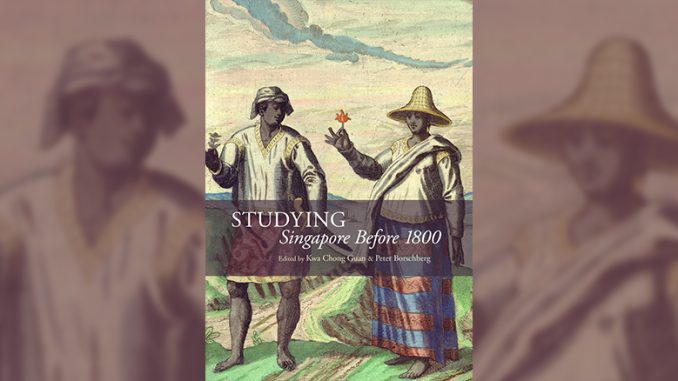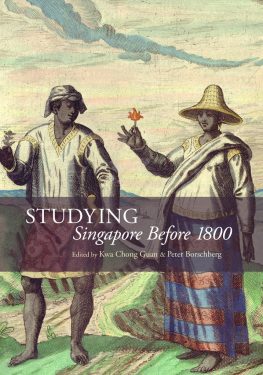
Studying Singapore Before 1800
Kwa Chong Guan & Peter Borschberg (Eds.)
NUS Press, 2018
In 2019, Singapore celebrated the 200th anniversary of Sir Stamford Raffles’ arrival in Singapore. Launched as the “SG Bicentennial”, there was good reason to believe this to be another cynical marketing campaign. For one, the bicentennial was dubbed as a prequel to “SG50”, the ubiquitous branding exercise that marked Singapore’s 50th year of independence in 2015. That year, Singaporean consumers were sold a deluge of SG50-themed promotional products like SG50 tinned sardines and even SG50 health insurance. Independence, it seemed, had not resulted in freedom from commoditisation.
In the end, the 2019 bicentennial did not plumb the nadir of 2015’s consumerist depths. Perhaps “SG Bicentennial” was not as catchy as “SG50”. I posit, however, that another reason might be because people usually do not have much patience for messy history. Singaporeans in particular, typically prioritise looking forward rather than backwards. (Being Singaporean myself, I speak with experience.) Historical narratives, if they are to resonate with Singapore’s zeitgeist, have to be simple, unambiguous, and teleologically driven by a myth of individual merit. Witness the appeal of the great man narrative, as personified by a Lee Kuan Yew or Raffles, who through force of will (never by stroke of luck) overcame obstacles to secure the future of the nation. Such a narrative could not hold for the bicentennial, which − to the credit of its organisers − had framed Singapore’s history to encompass some 500 years before Raffles’ arrival in 1819. Moving so far in the past necessarily made Singapore’s history much messier, more resistant to being reduced to a consumerist manifesto.
 This brings me to Studying Singapore before 1800, comprised of 18 articles on Singapore’s pre-colonial past curated by Kwa Chong Guan and Peter Borschberg of the National University of Singapore. All of the articles except the introduction have been previously published. Several, like an article by Pieter Gerritsz Rouffaer on the identity and location of Malayur before 1400 CE, are more than 50 years old, and might be difficult to find without access to specialist journals. Nevertheless, these articles are still insightful because of the fascinating historical detective work that their authors conducted on source material, like Javanese texts or Chinese maps, to uncover the hidden history of Singapore and the region.
This brings me to Studying Singapore before 1800, comprised of 18 articles on Singapore’s pre-colonial past curated by Kwa Chong Guan and Peter Borschberg of the National University of Singapore. All of the articles except the introduction have been previously published. Several, like an article by Pieter Gerritsz Rouffaer on the identity and location of Malayur before 1400 CE, are more than 50 years old, and might be difficult to find without access to specialist journals. Nevertheless, these articles are still insightful because of the fascinating historical detective work that their authors conducted on source material, like Javanese texts or Chinese maps, to uncover the hidden history of Singapore and the region.
Collectively, the articles compiled in this volume remind us that Singapore’s history is comprised of many narratives, is open to multiple interpretations, and is not necessarily undergoing a linear march towards progress. Kwa’s introduction helpfully frames the complex, shifting nature of what, and even where, Singapore was before Raffles’ arrival as a historiographical question about the “paradox of Singapore history”. Why did notable historians like K.G. Tregonning and Wong Lin Ken (both Raffles Professor of History at the University of Malaya), and Mary Turnbull (author of A History of Modern Singapore), despite being aware of existing historical studies that pointed to Singapore’s strategic importance in the centuries before Raffles’ arrival, all make the arrival of Raffles in 1819 the “incontestable foundational event in Singapore’s past” (Kwa 2018, 3)?
Kwa’s question strikes me as significant from the perspective of a sociology of knowledge. His answer, which I paraphrase here, was that Tregonning, Wong, and Turnbull’s views of Singapore’s history were coloured by the need to make sense of post-colonial Singapore and the rapid developments that Singapore was undergoing at the time of their work. They had witnessed the momentous events in Malaya in the 1950s and were historians in the 1960s and 1970s. Living in that milieu, they could not connect the contemporary context they were working in as historians with the views of the “antiquarian” histories – some of which are collected in this volume.
It seems that Tregonning, Wong, Turnbull, and by extension their students, comprised what Ludwik Fleck called a “thought collective” – a community of persons involved in exchanging ideas that also serve as “carriers for the historical development of any field of thought, as well as for the given stock of knowledge and level of culture” (Fleck 1979, 39). As Kwa mentioned in his introduction, the stock of knowledge for historians like Tregonning and Turnbull, carrying on from Lennox Algernon Mill’s 1924 study of British Malaya, had come mainly from the colonial archives and records of the East India Company, the source of the “basic materials for the reconstruction of their immediate past” (Kwa 2018, 16).
Studying Singapore Before 1800, in compiling the work of historians whose sources draw from old texts and depictions of and about the region, presents to the reader other thought collectives that had been peripheral or overlooked. In doing so, it opens up a larger well of possible identities that, not only students of Singapore but Singaporeans themselves, can draw on without being reduced to a brand on a sardine tin.
Reviewed by
Alex Tham
Independent Scholar, Singapore
Reference:
Fleck, Ludwig. 1979. Genesis and Development of a Scientific Fact. Chicago: University of Chicago Press.
Kwa Chong Guan. “Introduction.” In Studying Singapore Before 1800, edited by Kwa Chong Guan and Peter Borschberg, 1-26. Singapore: NUS Press.
